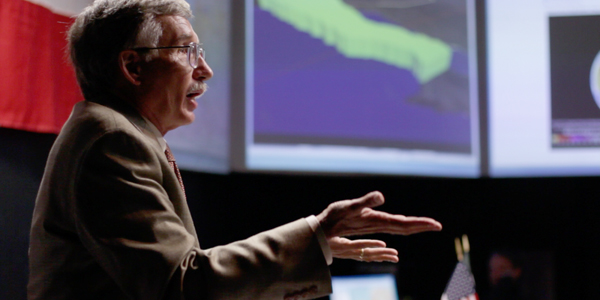
SDSU's Eric Frost explains his concept for an 'asset map' to serve the Mega Region initiative. (Photo by Jerick Evans)
A map became much more than just a map this week at San Diego State’s Visualization Center.
According to Eric Frost, the interactive map he is helping to create for the new Cali-Baja Bi-National Mega Region will identify opportunities and services from a regional perspective, unlike anything that’s been created before.
The Mega Region Initiative
Business leaders and government officials from Baja California, Mexico; and San Diego and Imperial Counties celebrated together at the Viz Center the signing of a memorandum of understanding that officially launched the Cali-Baja Mega Region initiative, developed to capitalize on the larger region’s diversified assets.
“Together with our partners, we are committed to marketing the assets of the region as a whole,” said Julie Meier Wright, president and CEO of the San Diego Regional Economic Development Corporation. “Under the MOU, deal flow and transactions with client companies interested in locating to or expanding in Cali Baja will be driven by a regional approach to economic development.”
SDSU’s Involvement
Organizers of Cali Baja hope to maximize the mega region’s marketing position for business investment. The agreement marks the beginning of the formal marketing efforts, including the development of a regional “asset map,” which Frost explained will be a new way of looking at and creating maps.
“When you look at a map of California, what do you see in Mexico? Nothing,” said Frost, co-director of the Viz Center. “And when you look at a map of Mexico, what do you see in California? Nothing.”
Creation of a New Kind of Map
He explained that he is going to develop an asset map that shows business opportunities without borders, such as areas in the region with the most powerful wind supply, for potential wind farms. And he showed a regional view of the coast line where biological research can be done in previously untapped waters. A regional approach to looking at natural and human resources could open doors to new technological developments and economic opportunities.
SDSU President Stephen L. Weber spoke at the event about the importance of cooperation and collaboration, and the history of SDSU working closely with its neighbors. He cited two campuses in the Imperial Valley and the first bi-national degree between Mexico and the United States that was begun 20 years ago at SDSU.
Additionally, the Cali-Baja website was built by a team of students at SDSU’s Entepreneurial Management Center’s WebCompass program.
Organizations signing the understanding agreement included:
San Diego Regional EDC
Imperial Valley EDC
Tijuana EDC
Economic Promotion Commission of Ensenada
Economic Promotion Commission of Tecate
Industrial Promotion Commission of Mexicali

